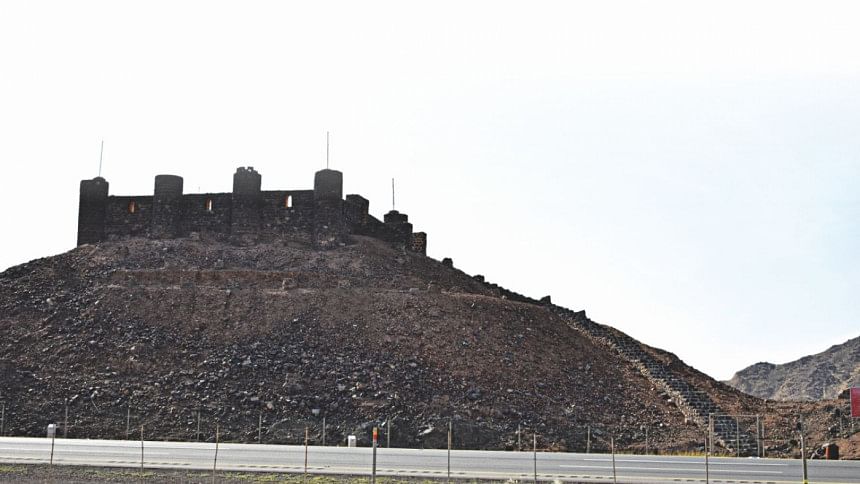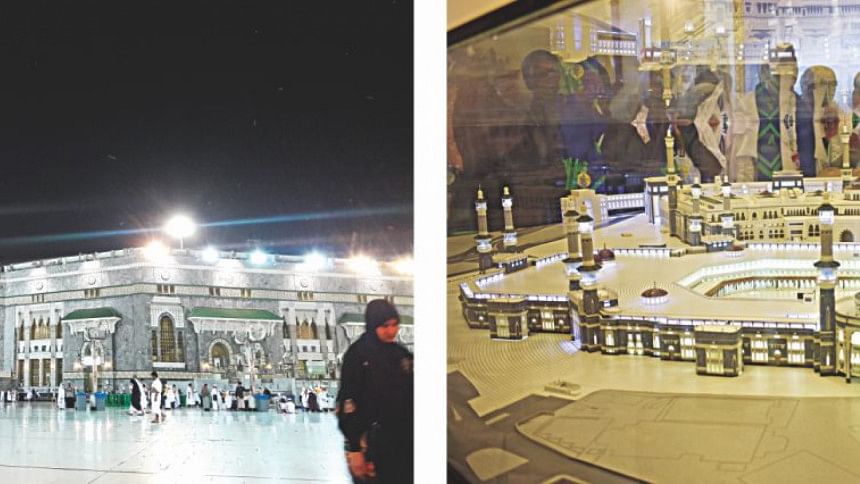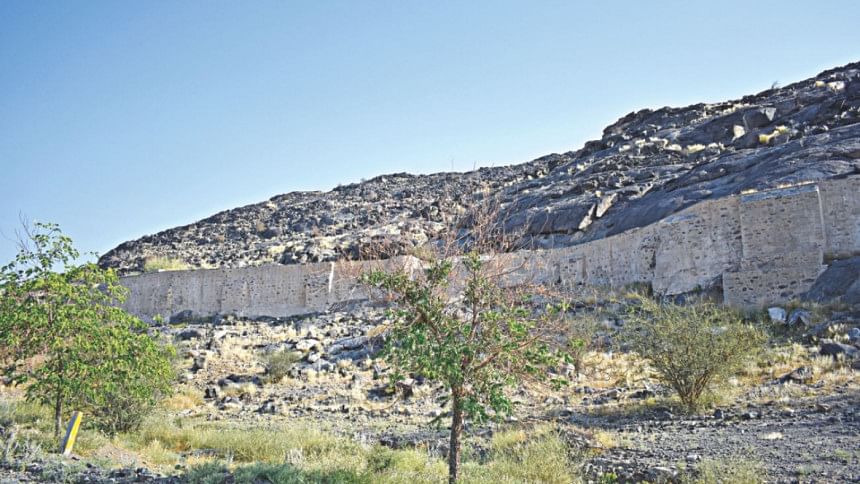To the sacred cities

One of the first set of story books I received, read, and till date cherish, are about the Sirah — the life of the beloved Prophet Muhammad (S). These books were so well written that despite being colourless with artistic but very bare-boned drawings, the stories came alive. This year I feel I was blessed to finally make the pilgrimage of religious binding, which for me slowly became one of freshly piqued curiosity, and then of utmost respect, renewed.
The first thing to hit me was the acute lack of sense of time. We landed in the holy city of Makkah first, and no matter which city claims to stay forever awake, this one surely does. The Haram, or the sacred mosque with the Kaaba, is always full of worshippers. The numbers may vary, but never too few enough to call it even slightly empty.
The first order of business for anyone who has made the niyyat (intention) of doing an Umrah is to complete that, but much to our chagrin, we arrived in the middle of the night, for the bus service that was part of a package turned out to be our one and only mistake in the organisation of this trip.
As my parents had performed the Hajj some years ago, we did not need any guide for the religious part of the pilgrimage, in fact they were so good at it, that we teased about offering people their guide services!
The first sight of the Kaaba for me happened the next day. I had heard about it being majestic, which it is, and being larger than it looks, which it is, but the House of God seemed dwarfed against the reach of capitalism, as towering concrete structures loom over the ancient black-clad room Muslims pray to daily.
I was expecting to be overwhelmed, but sadly that did not happen, perhaps my now innate cynicism, or the usual slow response, was at work. The first couple of days the significance of the place did not sink in.
As we approached the Kaaba complex, or the main holy mosque, I could see people's emotions gushing out — teary eyes, louder and more fervent prayer chants. But it did not feel like chaos, neither was it intimidating.
The basic elements of the Umrah are simple, and we were already in 'Ihram,' so we proceeded to the main Kaaba courtyard, also called the Mat'af, and started the circumambulations, and together completed the required seven.
It was more or less a comfortable walk around the Kaaba, and we were lucky to get pretty close by, which also cut down the distance that many pilgrims have to cover if they do the tawaf on the second or third floor, or even the outer most circle.
As my memory among our group was the weakest, I could not easily memorise the duas needed, but Allah allowed a me a cheatcode, I feel, as the leaders of many Umrah groups would recite duas loudly for their followers to hear and recite, and I just picked the one I liked to recite along, and sent them a silent blessing for making my tawaf easy.

It is quite easy to lose count of how many circuits you have done in all the constant movement and chanting, so we carried a string with seven beads, easily available around the Kaaba. The total walk for a single Umrah now, as we have cars to come into the city and to the mosque itself, is a little more than five miles, including the tawaf and the Sa'i, the seven runs between the Safa and the Marwa. The rocky hillocks are now inside the mosque, but the sheer distance and my imagination gave me some idea, and immense respect for Hajera, Prophet Ibrahim's wife, and her faith and hardship.
Next on the agenda was to try and touch the Kaaba, which after considerable struggle, we managed to reach without trampling or getting trampled. My sister and mum then wanted to try touch the Hajr-e-Aswad, (the Black Stone), and they did, after great personal danger of injury.
I bowed out, although it would have been a great blessing, but looking at the sheer madness that surrounded the stone, as people shoved, pushed, nudged and elbowed each other to try and get to it, discouraged me from even trying, as I did not want to end up losing my temper or getting injured over this.
We took one day to visit the places of historic significance around the city, and the tour ended at the base of the Jabal-e-Noor, or the Mountain of Light, where Islam was first revealed to Muhammad, inside the small cave of Hera.
We climbed to the very top, as now there are stairs, but it took us about three hours, with rest and water breaks. The sheer rocky surface and unyielding façade of the mountain was intimidating, to say the least.
The climb up was uneventful, but the actual entrance to the cave was anything but. There was a tiny claustrophobia inducing passage through boulders, opening into a tiny courtyard, barely large enough for 10-15 people to stand without allowing movement. The cave only large enough for one person, and perhaps a child to sit it.
Looking around from the top, I could see why Muhammad (S) would choose this place to meditate, but I wondered how his wife Khadija (R) managed to climb this again and again with food and water, days on end. What kind of love and devotion allows that kind of support, I wondered.
Also, the words behind every great man is a great woman, never rang truer to me.
There are many things I would criticise the current Saudi regime for, but management of the Kaaba is not one of them.
The entire system runs efficiently, the place remarkably clean and stocked for the sheer number of pilgrims it caters to every day. Truly a marvel.

When it was time to leave Makkah, I did silently lament the time I did not take out to organise my duas, as if Allah needs an itemised list of demands, so I consoled myself thinking that He knows what desires reside in the truth of my heart.
We drove to Madinah from Makkah, and luckily the person at the wheel, Mr. Khurshid, was well versed on the roads and knowledgeable of the remains and their significance, which made the drive even more pleasant.
Since the trip was not during the Hajj season, we were fortunate to visit some of the historic sites attributed to the Prophet (S) and his nearest people. The house that Muhammad (S) was born in, right behind the Kaaba complex today, has been turned into a library. Sadly, it is no longer accessible to regular people.
We also went to see the field of Badr, the first battle of Islam, where the heavily outnumbered faithful received reinforcements as angels came to increase their ranks. We took some photos of the dilapidated houses that are said to have been from the time of the Prophet, belonging to some of his blessed companions.
Regardless, we said a prayer at the martyrs' graves, and went on with our remembrance tour. There are two wells said to have been blessed ones, Beer-e-Shifa and Beer-e-Rowha, and both are revered as being attributed to the Prophet (S), and narrations claim that the water of each has healing for believers. Allah knows best!
The arrival into Madina Munawwara was peaceful, the place looked inviting, and calm. As we approached the Haram, or the Prophet's mosque, and found our hotel, the instant first impression was of calm, perhaps as the streets were not so busy in that district and there was a cool breeze blowing for it being the middle of winter.
After settling in, we went off to say our salams to the Prophet (S), as close to his grave as possible, and had to rush as the site is open for women for only a few hours throughout the day, and a mad jostling is an ever present scenario at the gate of the female enclosure. We got through that somehow, and managed to pay our respect, but were utterly exhausted after, and hated the really long walk that was to the female gates, as the male gate was empty and right in front of our nose!
The Prophet's mosque is beautiful, and tranquil, and very inviting, except the invasive checking of the bags felt a little annoying. But in a couple more days when it was time to leave, I did feel a slight pull to stay back, and a stronger one to come back more prepared, and with a more well-though out list of prayers, for sure!
The next day we set off on a taxi to do the Ziyara circuit, by which the car takes you to the commonly known places of historical places like Islam's first mosque at Quba, Masjid-e-Qiblatain, where the Qibla was changed mid-prayer from Jerusalem to Makkah, and the cemetery of martyrs at mount Uhud.
A short 10-minute or so walk away from the grand mosque is the place of the battle of Khandaq (trench) and there is a fort in ruins, but it is closed to visitors, sadly.
We also took a drive to the so called Wadi-e Jinn, or locally known as Wadi-e Beza, where some strange phenomena push cars without ignition up to speeds of 90 km per hour. Interesting as it is, I find it suspicious that the powerful Jinn nation would be sitting around pushing curious tourists!
A highlight of my Madinah visit was the Darul Madinah Museum. It has an entry of 25SR, but the service is worth every bit. There are guides available, fluent in Arabic, Bangla, and Urdu, who clearly and systematically take visitors through various dioramas, some small, some large, all incredibly detailed, to create a short summary of the Prophet Muhammad (S) life, with more emphasis on his stay in Madinah. Before the visit, I did not know that the migration, or Hijrah as Muslims call it, took one and a half months to complete, nor that the three sides of the blessed city is made up of charred mountains from volcanic eruptions!
I also did not know there are at least 90 mosques around the city where Rasul (S) had prayed.
There was also a very interesting display about the beloved animals and pets of the Prophet, including his camel Qiswa that cried herself to blindness after his demise, and died from starvation by refusing food. That was just one of the heart-breaking stories. The display of how the Kaaba came to be as it is today, was also enlightening. I wish I had more time to absorb each piece into my memory.

Photo: Sania Aiman

 For all latest news, follow The Daily Star's Google News channel.
For all latest news, follow The Daily Star's Google News channel. 



Comments